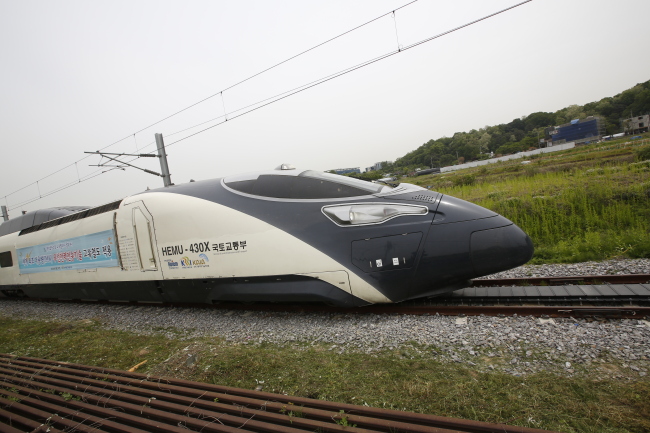Consumer electronics such as smartphones and toothbrushes are not the only things that can be charged wirelessly anymore. Korean researchers have developed ways to adapt such technology into high-speed railways.
The Korea Railroad Research Institute recently introduced the world’s first bullet train that can be powered wirelessly without overhead electric grids, in Uiwang, Gyeonggi Province.
The researcher demonstrated the so-called online electric train, named “Hemu,” equipped with the wireless electric charging system in some of its engines.
As soon as it can fully embed the system in all eight engines required to power and operate the mobile train, Hemu can emerge as the country’s next-generation bullet train, traveling faster than the KTX and able to replace it.
 |
This wirelessly powered high-speed train was unveiled by the Korean Railroad Research Institute on Tuesday in Uiwang, Gyeonggi Province. (KRRI) |
“When fully equipped, the wireless electric train can go up to 430 kilometers per hour,” a KRRI official said.
Hemu will not only be able to go faster but also gain greater flexibility and mobility as it gets its power from underneath the rail tracks, where there is another system that can constantly transmit and feed 1 megawatt of electricity to the speeding train.
The power it receives is equivalent to running 10 large buses, the KRRI noted.
Given that it does not need conventional grids, Korea will be able to reduce construction and maintenance costs for the new train, which has so far showed 83 percent efficiency in wireless power transmission.
Air and noise pollution can also be reduced if online electric trains can replace diesel-powered ones.
Also, this technology could lead the rail industry to develop and operate other types such as double-decker trains.
The KRRI said it may take more time to fully commercialize the train, noting that it could perhaps do so in phases after 2017.
“We will make further efforts to commercialize the train by developing smaller and lighter power equipment and securing a stable wireless electric transmission,” said Lee Jun-ho, senior researcher at the institute.
The rail researcher first developed a prototype of its wireless electric train in 2013 with the Korea Advanced Institute of Science and Technology, a state-run research university that also invented a wirelessly powered electric bus.
By Kim Young-won (
wone0102@heraldcorp.com)








